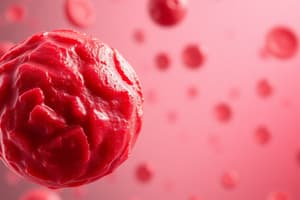Podcast
Questions and Answers
A patient's blood test reveals a hemoglobin level below the reference range. Which condition is most likely indicated by this result?
A patient's blood test reveals a hemoglobin level below the reference range. Which condition is most likely indicated by this result?
- Anaemia (correct)
- Thrombocytosis
- Leukocytosis
- Polycythemia
A patient presents with fatigue and microcytic hypochromic anaemia. Which of the following is the most likely underlying cause?
A patient presents with fatigue and microcytic hypochromic anaemia. Which of the following is the most likely underlying cause?
- Vitamin B12 deficiency
- Folate deficiency
- Aplastic anaemia
- Iron deficiency (correct)
A patient is diagnosed with sideroblastic anaemia. The underlying mechanism involves:
A patient is diagnosed with sideroblastic anaemia. The underlying mechanism involves:
- Impaired iron utilization (correct)
- Increased red blood cell destruction
- Decreased globin chain synthesis
- Increased iron absorption
What is the primary defect in thalassemia that leads to anaemia?
What is the primary defect in thalassemia that leads to anaemia?
Exposure to lead can result in a specific type of anaemia. Which of the following is commonly associated with lead poisoning?
Exposure to lead can result in a specific type of anaemia. Which of the following is commonly associated with lead poisoning?
A patient with chronic kidney disease develops anaemia. This is primarily due to:
A patient with chronic kidney disease develops anaemia. This is primarily due to:
A patient has been diagnosed with aplastic anaemia. The primary issue in this condition is:
A patient has been diagnosed with aplastic anaemia. The primary issue in this condition is:
A patient develops haemolytic anaemia after starting a new medication. Which of the following mechanisms is most likely responsible?
A patient develops haemolytic anaemia after starting a new medication. Which of the following mechanisms is most likely responsible?
A patient with a history of gastrectomy is at risk of developing which type of anaemia?
A patient with a history of gastrectomy is at risk of developing which type of anaemia?
A pregnant woman is diagnosed with anaemia. What is the primary cause of anaemia during pregnancy?
A pregnant woman is diagnosed with anaemia. What is the primary cause of anaemia during pregnancy?
Why is iron absorption commonly impaired by the consumption of tea with meals?
Why is iron absorption commonly impaired by the consumption of tea with meals?
What is the significance of Howell-Jolly bodies found on a peripheral blood smear?
What is the significance of Howell-Jolly bodies found on a peripheral blood smear?
A patient with hemolytic anaemia presents with jaundice and dark urine. What is the underlying cause of these symptoms?
A patient with hemolytic anaemia presents with jaundice and dark urine. What is the underlying cause of these symptoms?
A patient taking phenytoin for seizure control develops megaloblastic anaemia. Which vitamin supplementation is most appropriate?
A patient taking phenytoin for seizure control develops megaloblastic anaemia. Which vitamin supplementation is most appropriate?
Which of the following conditions is most likely to cause warm autoimmune hemolytic anaemia?
Which of the following conditions is most likely to cause warm autoimmune hemolytic anaemia?
A patient presents with fatigue, splenomegaly, and pancytopenia. Bone marrow examination reveals fibrosis. Which condition is most likely responsible?
A patient presents with fatigue, splenomegaly, and pancytopenia. Bone marrow examination reveals fibrosis. Which condition is most likely responsible?
What pathological finding would suggest iron deficiency anaemia?
What pathological finding would suggest iron deficiency anaemia?
What is a common clinical symptom of Vitamin B12 deficiency?
What is a common clinical symptom of Vitamin B12 deficiency?
Following an increase in RBC production brought on by haemolysis, what might one expect to find in urine?
Following an increase in RBC production brought on by haemolysis, what might one expect to find in urine?
What is the effect of hereditary spherocytosis on osmotic fragility?
What is the effect of hereditary spherocytosis on osmotic fragility?
Flashcards
What is Anaemia
What is Anaemia
Reduction in blood hemoglobin below reference levels for age and sex.
Hypochromic Microcytic
Hypochromic Microcytic
Small, pale red blood cells, often due to iron deficiency.
Normochromic Normocytic
Normochromic Normocytic
Red blood cells of normal size and color, but reduced in number.
Macrocytic
Macrocytic
Signup and view all the flashcards
Aplastic Anaemia
Aplastic Anaemia
Signup and view all the flashcards
Haemolytic Anaemia
Haemolytic Anaemia
Signup and view all the flashcards
What is Leukaemia
What is Leukaemia
Signup and view all the flashcards
What is Malabsorption
What is Malabsorption
Signup and view all the flashcards
Anaemia of chronic disease
Anaemia of chronic disease
Signup and view all the flashcards
Anaemia from Blood Loss
Anaemia from Blood Loss
Signup and view all the flashcards
Sideroblastic anaemia
Sideroblastic anaemia
Signup and view all the flashcards
Thalassemia
Thalassemia
Signup and view all the flashcards
Pernicious anaemia
Pernicious anaemia
Signup and view all the flashcards
Folate Deficiency
Folate Deficiency
Signup and view all the flashcards
G6PD Deficiency
G6PD Deficiency
Signup and view all the flashcards
Spherocytes
Spherocytes
Signup and view all the flashcards
Iron overload
Iron overload
Signup and view all the flashcards
Haemolysis
Haemolysis
Signup and view all the flashcards
Malaria related anaemia
Malaria related anaemia
Signup and view all the flashcards
Hypersplenism
Hypersplenism
Signup and view all the flashcards
Study Notes
- Anemia involves a reduction in blood hemoglobin (Hb) below the reference level for age and sex.
- For males, it's below 13.5g/dL.
- For females, it's below 11.5g/dL.
- MCV (mean corpuscular volume) typically ranges from 76-100fL.
Types of Anemia
- Hypochromic microcytic anemia includes iron deficiency, sideroblastic anemia, thalassemia, lead (Pb) poisoning, and anemia of chronic disease (CD).
- Normochromic normocytic anemia includes anemia of chronic disease and aplastic or hemolytic anemia
- Macrocytic anemia can be megaloblastic or non-megaloblastic.
- Megaloblastic causes include vitamin B12 and folate deficiency.
- Non-megaloblastic causes include alcohol, methotrexate, myelodysplastic syndromes (MDS), hypothyroidism, and liver disease, causing an increase in reticulocytes.
Iron Deficiency
- Reduced iron intake occurs in adolescents and pregnant individuals.
- Reduced iron absorption is associated with gastrectomy, tea consumption with meals, malabsorption, and chronic antacid use, leading to achlorhydria.
- Increased iron utilization happens during growth spurts, pregnancy, and lactation.
- Blood loss can be due to GI bleeds from peptic ulcers, esophageal varices, GI cancer, or hookworm/whipworm infections.
- Excessive anticoagulation, hereditary hemorrhagic telangiectasia, and angiodysplasia of the colon causes blood loss
- Arteriovenous (AV) malformations also cause bleeding.
- Menstrual blood loss.
Sideroblastic Anemia
- Sideroblastic anemia results from an enzyme deficiency that impairs iron utilization, causing iron to accumulate around the nucleus of red blood cells (nRBC).
- Congenital/inherited sideroblastic anemia is X-linked recessive and primarily affects males.
- Acquired sideroblastic anemia is associated with INAH, alcohol, phenytoin, MDS, myeloid leukemia, and myeloproliferative disorders.
Thalassemia
- Thalassemia involves a mutated globin chain around the heme group.
Lead Poisoning
- It presents with anemia, blue lines on the gums (PbS lines), colic, constipation, wrist drop with paralysis, muscle atrophy and tremors, and encephalopathy with convulsions.
Anemia of Chronic Disease (CD)
- Anemia of CD is related to infective endocarditis, TB, osteomyelitis, SLE, RA, polymyalgia rheumatica, IBD, malignancy, chronic renal failure (CRF), and multiple myeloma, resulting in decreased iron utilization and response to erythropoietin.
- High hepcidin levels reduce iron absorption and release from macrophages.
Aplastic Anemia
- Aplastic anemia results in bone marrow (BM) failure.
- Inherited causes include dyskeratosis congenita, and Fanconi anemia (AR with dysmorphic features, renal, neuro, and skeletal issues).
- Acquired aplastic anemia is caused by infections like EBV, HIV, Parvo, Hep A/B, TB, chemotherapy, radiation exposure, pregnancy, PNH, myelodysplasia, and chemicals.
Hemolytic Anemia
- Intracorpuscular/congenital causes are cell membrane defects like hereditary spherocytosis (HS), hemoglobinopathies such as thalassemia and sickle cell disease, and enzyme deficiencies such as G6PD and pyruvate kinase (PK) deficiency.
- Extracorpuscular/acquired causes involve autoimmune disorders using warm or cold antibodies, drugs, penicillin, HDN, prosthetic valves, and toxins.
- BM infiltration is seen in MPD, MF, leukemia, lymphoma, and multiple myeloma.
General Anemia Information
- Anemia results from RBC loss (acute/chronic), impaired production due to nutritional deficiency or BM failure, and RBC destruction.
Patient History
- Shortness of breath (SOB) on exertion, tiredness, and faintness are common symptoms.
- Differential diagnosis includes anemia, congestive heart failure (CHF), subacute bacterial endocarditis, hypothyroidism or hypopituitarism.
- Age is relevant, with children often associated with thalassemia, males with GI CA, PUD, G6PD, sideroblastic anemia, young females with iron deficiency or autoimmune HA, middle-aged females with iron deficiency or pernicious anemia, and the elderly with aplastic anemia
Symptoms and Progression
- Symptoms onset can either be rapid which indicates acute bleeding, acute leukemia or acute hemolysis or insidious which is usually related to deficiency related anemia or aplastic anemia
- Worsening of symptoms can include angina, ischemic claudication, and other anemic features such as faintness, palpitations, LOA, difficulty to concentrate/headache
Possible conditions the Doctor should exclude
- CCF (orthopnea/PND/ankle swelling)
- SBE (fever, chest pain, palpitations)
- Hypothyroidism (cold intolerance, weight gain, decreased appetite, hair loss)
- Hypopituitarism (decreased skin color)
- Syncope (fainting spells on prolonged standing/fear/pain/exertion
Underlying Causes of Blood Loss
- Acute blood loss can be due to PPH, recent trauma or surgery.
- Chronic blood loss includes hemorrhoids, IBD, GI cancer, PUD/GORD, and hookworm infestation.
- Menstrual loss is characterized by >7days, clots, flooding, >3 pads/day, high parity, and narrow gap between pregnancies, CLD, and Hx of bleeding disorder
Impaired Red Cell (RC) Production
- Nutritional deficiencies includes Vitamin B12, primarily from animal sources, and folate, exclusively from plant sources.
- Diet can also impact red cell production
- Diet: Frequency of red meat, tea with meals (affects iron), vegetarian or poor diet (B12), and consumption of green vegetables (folate).
- Malabsorption is linked to conditions such as chronic diarrhea, steatorrhea, LOW, poor growth, IBD, and a history of TB.
- Losses of Folate can occur with renal dialysis, chemotherapy, and inflammation (high cell turnover).
- B12 Deficiency features include tingling or numbness, memory disturbance, apathy, visual disturbance and psychosis
- Homocysteinuria causes subfertility, limb weakness and PVD
- Iron deficiency can be identified with pica, dysphagia, and sore tongue (Plummer Vinson Xn) and tinnitus
- Celiac disease causes reduced iron absorption
Other potential health conditions
- TB (cough, evening fever, night sweats, back pain)
- RA (joint pain with B/L) usage of NSAID
- IE, osteomyelitis, SLE, CRF, CLD, Diabetes Mellitus
Bone Marrow Failure (Primary)
- Due to thrombocytopenia
- Aplastic anemia is a pancytopenia (reduced blood cell counts) that spontaneous ICH can lead to craniotomy and dysmorphic features
- Congenital Aplastic Anemia: Fanconi's anemia (microcephaly, absent thumbs)
- Infections such as HAV, HBV, Parvo B19
- Rx: Chloramphenicol, sulphonamide, anti-malarial, anti-thyroid, tolbutamide, phenytoin
- Sickle cell disease (vaso occlusion)
- Immune related (SLE, RA, Sjorgrans)
- Marrow Infiltration with neoplasms (i.e. Leukaemia, Lymphoma, etc) or hematalogical related
- Nutritional deficiencies B12 or Folate
Red Cell Breakdown - Hemolysis
- Includes conditions like Jaundice, dark coloured urine, loin pain and biliary colic
- Present early in patients life
- Color of urine (clear, yellow, brown, red, cola) signifies problems with kidney health Clear: dilute and caused by overhydration Yellow: Healthy Orange: Concentrated and caused by dehydration Brown: Increased bilirubin Red: Blood, infection, tumor or drugs Cola: Rhabdomyolysis from muscle breakdown
Intravascular vs Extravascular Anemia (examples)
- Intravascular examples: Infections like "kuppamenia" anti-malarials and Hx of similar episodes of jaundice and anemia
- Extravascular: Family history of anemia and Hx of splenectomy
Hereditary Spherocytosis
- AD - Hereditary spherocytosis is affected in each generation.
- SHx is usually related to neglect/poverty
- Occupations with toxic chemicals.
Examination Tips:
GE/Fanconi anemia displays dysmorphic features and front bone bossing Hypothyroidism causes periorbital, dry skin and parase facies Malegoblastic anemia causes pale skin Addison disease cases hyperpigmentation and decreased BP
Hypersplenism
- RA causes felty's (thriad, RA,Splenogemy and Neutropenia
- Complications include cardiac stress, unstable angina, gallstones, Obstructice Jaundice (dark urine and pale stools) Syncopal attacks (with head trauma Rapid Anemia (family, hematalogical problems) Fhx
- AD Causes (spherocytosis: Genetic or acquired (G6PD or sideroblastic)
Investigations
- If high suspicion, do blood test and assess severity with ECG and cause like ESR
- Other test examples: CXR and USS
- BM and HA testing
If high reticulocyte count (>50) then:
- IV hemolysis - Elevated AST
- Indirect Hemolysis - hemolysis due to gilbert Syndrome
- Confirm sis (red blood cells)
- Check the blood test chart for more info
Studying That Suits You
Use AI to generate personalized quizzes and flashcards to suit your learning preferences.




